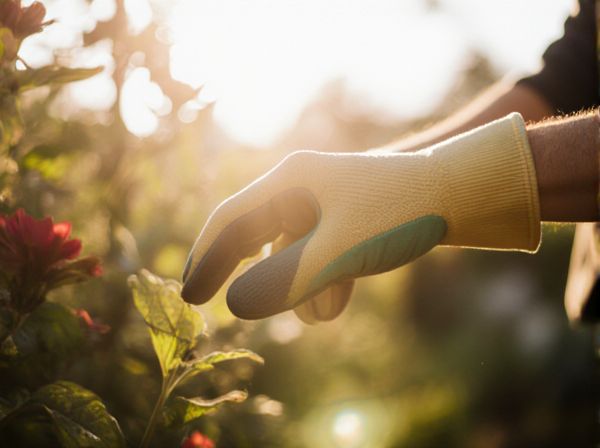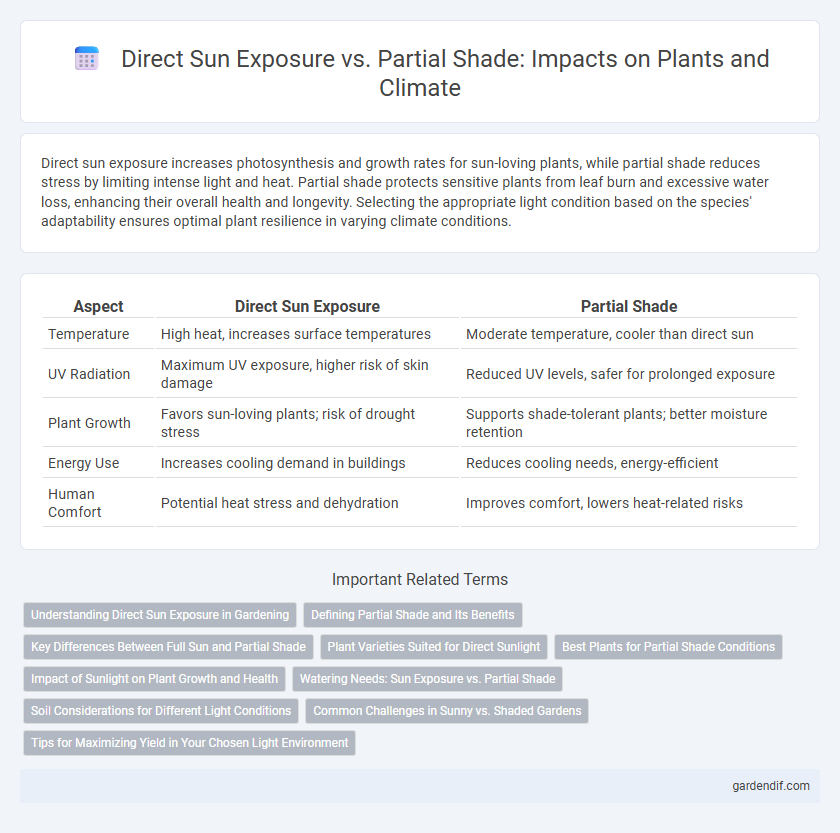
Direct sun exposure vs Partial shade Illustration
Direct sun exposure increases photosynthesis and growth rates for sun-loving plants, while partial shade reduces stress by limiting intense light and heat. Partial shade protects sensitive plants from leaf burn and excessive water loss, enhancing their overall health and longevity. Selecting the appropriate light condition based on the species' adaptability ensures optimal plant resilience in varying climate conditions.
Table of Comparison
| Aspect | Direct Sun Exposure | Partial Shade |
|---|---|---|
| Temperature | High heat, increases surface temperatures | Moderate temperature, cooler than direct sun |
| UV Radiation | Maximum UV exposure, higher risk of skin damage | Reduced UV levels, safer for prolonged exposure |
| Plant Growth | Favors sun-loving plants; risk of drought stress | Supports shade-tolerant plants; better moisture retention |
| Energy Use | Increases cooling demand in buildings | Reduces cooling needs, energy-efficient |
| Human Comfort | Potential heat stress and dehydration | Improves comfort, lowers heat-related risks |
Understanding Direct Sun Exposure in Gardening
Direct sun exposure provides plants with the full spectrum of sunlight for photosynthesis, promoting faster growth and higher yields in sun-loving species such as tomatoes and peppers. In contrast, partial shade offers protection from intense midday rays, reducing heat stress and water evaporation, ideal for shade-tolerant plants like spinach and lettuce. Understanding the specific sunlight requirements of each plant is crucial for optimizing garden placement and ensuring healthy growth throughout the growing season.
Defining Partial Shade and Its Benefits
Partial shade refers to locations receiving filtered or indirect sunlight for several hours daily, typically around 2 to 4 hours of direct sun combined with some shade. This light condition regulates temperature, reduces water loss, and protects sensitive plants from intense solar radiation and UV damage. Beneficial in moderate climates, partial shade supports biodiversity by allowing a diverse range of shade-tolerant and sun-sensitive species to thrive, improving ecosystem resilience.
Key Differences Between Full Sun and Partial Shade
Full sun areas receive at least six hours of direct sunlight daily, promoting vigorous photosynthesis and faster plant growth, ideal for sun-loving species like tomatoes and sunflowers. Partial shade zones experience four to six hours of sunlight or filtered light throughout the day, which reduces leaf scorch risk and retains soil moisture, benefiting shade-tolerant plants such as ferns and impatiens. Understanding these distinctions helps optimize plant selection and placement for climate-specific landscaping and agricultural productivity.
Plant Varieties Suited for Direct Sunlight
Plant varieties suited for direct sunlight include sun-loving species such as tomatoes, sunflowers, lavender, and zinnias, which thrive in full sun conditions of six or more hours daily. These plants exhibit resilience to heat and intense light, producing robust foliage and vibrant blooms due to their adaptation to high UV exposure. Selecting drought-tolerant and heat-resistant varieties further ensures optimal growth and productivity in areas with prolonged direct sun exposure.
Best Plants for Partial Shade Conditions
Plants that thrive in partial shade include hostas, ferns, and astilbes, all of which perform well with limited direct sun. These species adapt to reduced sunlight by developing larger leaves and efficient photosynthesis mechanisms, making them ideal for understory gardens. Choosing plants like hellebores and bleeding hearts enhances biodiversity while ensuring robust growth in shaded environments.
Impact of Sunlight on Plant Growth and Health
Direct sun exposure provides plants with maximum sunlight essential for photosynthesis, promoting robust growth and higher yields in species like tomatoes and sunflowers. Partial shade reduces light intensity, which can prevent leaf scorch and conserve soil moisture, benefiting shade-tolerant plants such as ferns and hostas. The balance between sunlight and shade significantly influences chlorophyll production, flowering cycles, and overall plant health, affecting nutrient absorption and resilience to climate stressors.
Watering Needs: Sun Exposure vs. Partial Shade
Direct sun exposure increases plant transpiration rates, resulting in higher watering needs to prevent dehydration and stress. In partial shade, plants experience reduced evaporation, allowing soil moisture to last longer and decreasing the frequency of watering. Proper adjustment of irrigation schedules based on sun exposure enhances plant health and conserves water resources.
Soil Considerations for Different Light Conditions
Soil in direct sun exposure often dries out quickly, requiring sandy or well-draining soils to prevent root rot and overheating. In partial shade, soils retain moisture longer and benefit from higher organic matter content to support plant health and microbial activity. Adjusting soil amendments based on light conditions improves water retention and nutrient availability, optimizing plant growth in varying climates.
Common Challenges in Sunny vs. Shaded Gardens
Direct sun exposure in gardens often causes soil to dry out quickly, leading to water stress for plants and increased evaporation rates that necessitate frequent irrigation. In contrast, partial shade gardens face challenges such as reduced photosynthesis efficiency and higher susceptibility to fungal diseases due to moisture retention. Both environments require tailored approaches to manage temperature extremes and maintain optimal plant health under varying sunlight conditions.
Tips for Maximizing Yield in Your Chosen Light Environment
Optimize plant growth by selecting species suited to your light environment, as sun-loving crops like tomatoes thrive under direct sun exposure, while leafy greens prefer partial shade to prevent wilting. Implement shading techniques such as shade cloths in direct sun areas to reduce heat stress and improve fruit set, or use reflective mulches in partial shade zones to increase light availability. Regular monitoring of soil moisture and temperature ensures plants maintain optimal conditions, maximizing yield regardless of light intensity.
Direct sun exposure vs Partial shade Infographic

 gardendif.com
gardendif.com